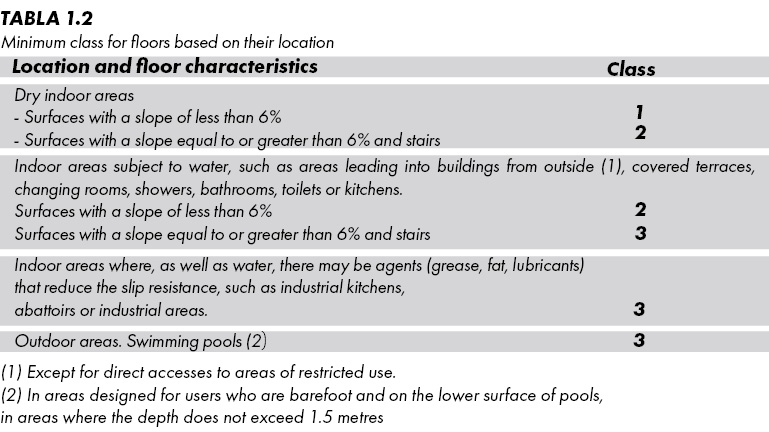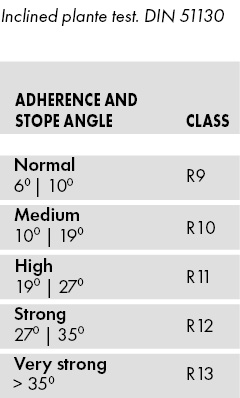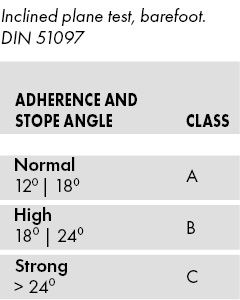The UNE EN stands, adopted by the CEN (European Committe for standardization) are valid throughout Europe and apply to all types of first choice tiles, pressed and extruded, glazed and unglazed, of any size. The UNE EN standards are compatible with the lastest amendments of the new ISO international standards, and incluide:
General regulations.
The new harmonised standard EN 14411 that provides definitions, classifications, features and designation requirements for ceramic tiles and cancel and replaces standard EN 87.
The new satandard UNE EN ISO 105454_1 that sets forth the rules for the composition of sample lots, and replaces the previous standard EN 163
Product regulations.
Ceramic tiles are divided into groups according to how they are formed and their water absorption characteristics. In terms of forming methods, there are two groups: A and B.
A – Exturdes tiles
(formed by means of passing a malleable paste through an extrusion machine; the resulting band is cut into the desired dimensions)
B – Pressed tiles
(obtined by pressing powdered raw materials in special molds). Afterwards, these tiles may be blazed or not.
The groups are broken down further according to their water absorptions characteristics (porosity)
The regulations define the sizes, the size tolerances, the mechanical, physical and chemical properties, the appeareance and designation of the ceramic tiles in each group.
Regulations for testing methods.
The regulations define the methods to be used for determining size and appearance characteristics, as well as physical and chemical properties.
Standard 14411 refers to the testing methods of the new UNE EN ISO 10545 Standard.


French QB UPEC certification provides the user with a quality guarantee: it confirms that the products delivered, marked with the QB and UPEC logos, comply with the prerequisites of the NF EN 14411 standard in accordance with the current certification rules and that they have the performance characteristics specified in the CSTB (Centre Scientifique et Technique du Bâtiment –
Scientific and Technical Centre for Building) “Technical Specifications for the UPEC Classification of Ceramic Floor Coverings”.
The four letters refer to:
U: resistance to foot traffic wear
P: mechanical resistance to the shifting of movable and fixed objects
E: resistance to water
C: resistance to commonly used chemicals
Suitability of ceramic tiles for installation on pedestals.
The full, up-to-date list of certified products can be viewed at www.cstb.fr
The DCOF AcuTest is an evaluation of the COF of a tile surface under known conditions using a standardized sensor prepared according to a specific protocol. Measurements are made with the BOT3000, an automated and portable device that measures DCOF. The ANSI standard A137.1–2012 also allows the use of other equivalent tribometers.
Wet measurements use 0.05% sodium lauryl sulfate solution to establish a thin film as would be present when a slip occurs. The precision, repeatability, and reproducibility of the DCOF AcuTest protocol is provided in the A137.1–2012 standard. The test was so named for easy recognition, and to distinguish it from other DCOF measurements using different instruments and/or protocols.
The DCOF AcuTest COF measurement is not a property of the flooring but rather a measurement of the interaction between the sensor, the lubricant, and the tile surface under controlled conditions.
It is useful to allow comparison between surfaces or to evaluate how a surface has changed over time. However, while the DCOF AcuTest can provide a useful comparison of tile surfaces, it cannot, nor can any other device, predict the likelihood a person will or will not slip on a tile surface.
Because many variables affect the risk of a slip occurring, the DCOF AcuTest measurement shall not be the only factor in determining the appropriateness of a tile for a particular application.
According to the ANSI A137.1–2012 standard, ceramic tiles selected for level interior spaces expected to be walked upon when wet must have a minimum wet DCOF AcuTest value of 0.42. Tiles with a lower value are not necessarily restricted to dry areas only, but rather are restricted to applications where they are kept dry when walked upon. In the case of residential bathrooms, the common use of bathmats can accomplish this. Similarly, in entranceways, the use of entrance mats can accomplish the same.
2. Floors are rated according to their Slip Resistance Rd as established in table 1.1

The slip resistance value Rd is determined using the pendulum method described in Appendix A of the UNE-ENV 12633:2003 standard, using Scale C on samples without accelerated wear and tear. The selected sample will be representative of the worst slip conditions.
Table 1.2 indicates the minimum class floors must have based on their location. This rating will be maintained during the useful life of the floor material
In order to limit the risk of slipping, floors in buildings or zones for Sanitary, Teaching, Commercial or Administrative Use, Car Parks and Public Areas, excluding areas of restricted use, will have a suitable rating as per point 3 of this section.

Test and normatives | Pendulum
This test is performed on a device in whitch the person performing the test walks on an inclined plane with a variable angle wearing a standardised soling material shoe. The surface is covered with oil. The angle o inclined plane that still allows to walk safely without slipping is the test measure.

test and normatives | Barefood test
This test is performed in a device in which the person performing the test walks barefoot on an inclined plane with a variable slope. The surface is covered with those tiles to be tested and is continually infused with a soapy solution.
The angle of the inclined plane that still allows to stand safely without slipping is the measure of the test.
